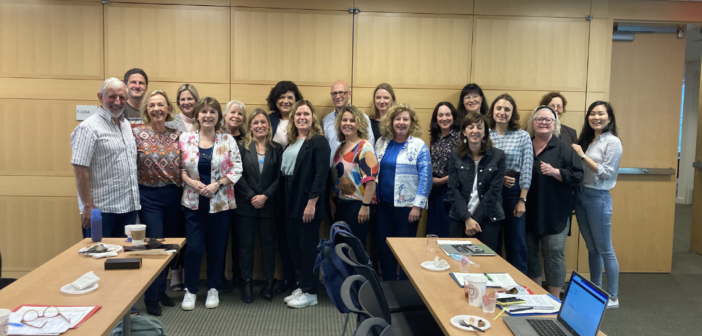As the COVID-19 pandemic continues to shift workplace dimensions and workers reprioritize their commitments, many people are opting to put work-life balance and mental health before extra hours in the office. Questions surrounding company culture and flexibility are now critical interview topics. If employers don’t shift company expectations along with the workers’, they may have difficulties retaining and recruiting quality talent.
But what about the responsibility of the government toward its people? Should the government step in on behalf of citizens to guarantee these benefits? And how would that policy affect workers?
One group in particular, the International Network on Leave Policies and Research (INLPR), has been having these discussions for 19 years. And this year, Fordham’s Graduate School of Social Service had the opportunity to host the INLPR’s 19th Annual Seminar and learn what decisions other countries and governments from around the world are making concerning parental leave.
The seminar, held at Fordham’s Law School, played host to nearly 30 members of the 60+ member network, from countries such as, but not limited to, Australia, Iceland, Germany, and Spain. The event was also live-streamed via Zoom, so that others from the network and across the globe could take part in the activities.
According to the INLPR’s website, the organization “provides a unique forum for exchange, dialogue and collaboration on issues of care, employment and gender. It consists of over 60 members, all experts on leave issues and who come from 49 countries across the world.”
The 2022 seminar was the second annual meeting that took place outside of Europe since the inaugural gathering in 2004, the first being the 2018 seminar in Toronto, Canada. Fordham GSS Professor and Mary Ann Quaranta Chair for Social Justice for Children Shirley Gatenio Gabel, Ph.D., organized the event along with fellow U.S. members of the INLPR network Cassandra Engeman, Gayle Kaufman, and Richard Petts.
“This is the first time the United States hosted the annual conference,” Gatenio Gabel said. “Fordham’s willingness to host the event speaks to its support for international, interdisciplinary partnerships, specifically those that support the evolving well-being of children, women and parents.”
Opening Remarks and Governmental Support
Graduate School of Social Service Dean Debra M. McPhee made the seminar’s opening remarks, welcoming all those in attendance and thanking them for their dedication to the research. McPhee discussed how the COVID-19 pandemic has shifted workers’ expectations about support—both financial and mental health—within the workplace, leading to what experts have called The Great Resignation.
“You all are championing changes for leave policies,” McPhee said to the room of scholars. “These are incredibly important conversations.”
Day one of the seminar was also highlighted by presentations from three governmental representatives: U.S. Senator Kirsten Gillibrand, Washington State Senator June Robinson, as well as former GSS Dumpson Chair and current NYC Deputy Mayor of Health and Human Services Anne Williams-Isom.
Gillibrand, who has introduced her legislation titled the FAMILY Act in every Congress since 2013, noted how important paid family leave is, not only for families, but for the economy and country as a whole.
“The U.S. is one of the only industrialized nations in the world with no national paid leave, medical, or sick leave policy,” Gillibrand said. “The FAMILY Act would ensure every worker, no matter the size of the employer—or if they’re self-employed or part-time—has access to paid leave every time they need it.”
Robinson, a Washington state Senator since 2013, gave the room an update on Washington State’s financial leave status as the first state to create a family leave program in the U.S. without an already underlying medical leave program. It is currently one of six states that offers Paid Family and Medical Leave benefits to workers.
“It was the right people in the right atmosphere,” Robinson said about passing that initial leave program in 2017. “That’s what happens in politics; you wait for that moment.”
GSS was also proud to welcome back Williams-Isom to campus. A Fordham alumna, as well as a former faculty member and former James R. Dumpson Chair in Child Welfare Studies, Williams-Isom joined NYC Mayor Eric Adams’s Office as the Deputy Mayor for Health and Human Services in January 2022.
Williams-Isom told the story of her mother moving to the states from Trinidad, and how she helped take care of her grandchildren while Williams-Isom and her husband pursued their careers. She noted that there are clear systemically racist issues in our country’s medical institutions and systems, and that leave programs have the potential to aid in equalizing those inequities. Williams-Isom went on to address skeptics of paid leave programs, who often ask the inevitable question of “how are you going to pay for that?” when the topic is discussed.
“I wish someone would ask that question for incarceration, or for our healthcare system issues,” she quipped.
Fathers’ Lack of Leave Uptake
One of the conference’s major themes revolved around fathers, and their historically low uptake of leave benefits and programs. Many of the presenters noted that fathers often do not take as much parental leave as mothers, even when given the same allowance of time to do so.
This was exacerbated by the COVID-19 pandemic, which saw, in most countries, an even further decrease in that uptake. One of the theories was that, due to national stay-at-home orders in their respective countries, more fathers were working remotely full-time. Therefore, instead of taking parental leave—which, in most cases, comes with a pay cut for that time period—they simply juggled the two responsibilities and hoped their employers would understand. Mothers were more likely to pick up more of the responsibilities for schooling, extra household chores, and caring during the pandemic.
Diane-Gabrielle Tremblay, INLPR member from Quebec, also noted in her research study titled “Fathers and parental leave in Québec; Results from recent surveys with fathers and employers,” that social stigma from employers and colleagues added to the fathers’ decisions to forego paternity leave. Survey respondents added that employers still put pressure on their employees about the length and timing of their paternity leave. This meshed well with other presenters, who found fathers increasingly postponing their leave benefits due to commitments at the office.
In Iceland, a shift in policy wording may have found a solution to at least part of this problem. Presenters Ásdís Aðalbjörg Arnalds and Guðný Björk Eydal detailed the language revision to the leave policy program in their country, which shifted the term “shared leave” to “transferable leave” when discussing paid leave time that can be taken by either mother or father. What might seem like semantics actually increased the amount of sharable time fathers took.
This last point highlights the importance of language in policy and the perception around leave within the workplace. As work-life balance is prioritized post-COVID, it’s not hard to imagine these conversations lessening the stigma around family prioritization.
Do Leave Policies Hurt Women’s Wages?
With echoes of WIlliams-Isom’s remarks on day one, day two presented a theme of systemic issues within the parental leave infrastructure that appears to damage women’s career potential.
Many of us know that women face undeserved scrutiny in the workplace because of their potential desire to have children, and, therefore, their necessity to take leave at some point in order to care for the newborn child.
Men often do not face this same scrutiny because:
- they will not need to take time off for the physical event of child labor, and
- fathers mostly do not take the leave they are granted, due to the reduced pay and social stigma that may come with it.
So, women already face a difficult task of landing their dream career due to stigma over potential child care, but how does it affect them when they actually do take the leave? Negatively, it seems.
In her presentation titled “Do unpaid parental leave schemes hurt mother’s wages? Evidence from Spain,” Irene Lapuerta explained a few theories as to why parental leave may impact mothers’ wages: deterioration on human capital, the low-commitment stigma, and family structure and resources.
- Deterioration of human capital – mothers’ work experience suffers with long periods of absence, since existing knowledge and skills depreciate due to lack of use
- Low commitment stigma – the ideal worker has no additional responsibilities and is focused exclusively on work. Taking leave is a sign of low commitment to work, and therefore mothers are discriminated against
- Family structure and resources – mothers’ work decisions depend on variables such as number of children, partner’s earnings and couples’ time allocations to paid and unpaid work
Her study did find that mothers’ monthly wages were penalized by a higher percentage if they took full-time leave from work. That penalty increased up to nearly 20% for mothers with three children, who took full time leave of one year per child.
Perhaps the most extraordinary of Lapuerta’s findings is that mothers who did not take any leave still saw an increase in monthly wage penalty the more children they had. Mothers who had three children saw nearly a 15% increase in that penalty.
Gender inequality within policies was also highlighted by Marian Baird from Australia, in her presentation “The effects and outcomes of Australia’s paid parental leave policy: evaluating a decade of evidence.” Baird outlined the original universal Australian policy of 18 weeks of parental leave paid at the national minimum wage, with the ‘primary carer’ or birth mother receiving 99% of the time and ‘secondary carers’ or fathers getting only .5.
And while the country has made some attempts to shape how leave should be used, Baird explained there is still a gendered pattern to those percentages — largely the burden still falls on mothers to leave the workplace.
Reducing the Stigma and Making Leave More Inclusive
Along with gender inequalities and stigmas concerning parental leave programs also comes the question of inclusiveness within these programs as well. This was highlighted by Alison Koslowski from England, who presented on both conference days, discussing parental leave access for recent immigrants, as well as the social inequalities inherently present in leave programs.
These inequalities stem from the decisions made by governments on who is excluded from leave programs and for what reason, whether that be gender-based, or socio-economically influenced. Koslowski argued that policymakers should view parental leave programs as a social right, and even spotlighted a gap in the research by discussing the possibility of viewing parental leave from a child’s perspective, stating that there is a “need to focus on the ‘right to receive care’, taking into account the child’s perspective or the perspective of another person in need of care.”
The conference concluded with a business meeting discussing the network’s goals for the upcoming year, including next year’s annual seminar, which will take place in Athens, Greece. That conference will continue the discussion of three key pillars as designed by the group:
- Leave policy and gender equality in the context of changing work forms and patterns
- Leave systems, care culture and gender equality
- Leave policy, aging societies and adult/elderly care
Overall, the work of the INLPR and all of its members is a continuous battle to convince governments, corporations, and the global public to buy-in to the benefits of leave policies — not only for the individual workers and their families, but for the global economy.
“Although paid parental leave has widespread public support and there is strong evidence demonstrating the physical, emotional, and economic benefits for parents, children, and businesses, the United States remains a laggard regarding ensuring paid leave for all workers,” Gatenio Gabel said. “About 56% of working parents in the U.S. are eligible for unpaid leave through the Family and Medical Leave Act (FMLA), enacted nearly 30 years ago. One-fifth of the states have paid leave programs, and some employers offer paid leave. Still, less than one-fourth of working parents in the U.S. take paid parental leave, which can reduce financial and emotional stress, give parents the time to bond with their new child, and stabilize family life. The current patchwork work system in the U.S. disadvantages Black, Hispanic, and Native American workers, especially women and low-income workers, who are less likely to be offered or afford unpaid leave from work than White, higher-income workers. Parental leave is a tool for reducing racial, income, and gender disparities, and supporting the well-being of families.”



